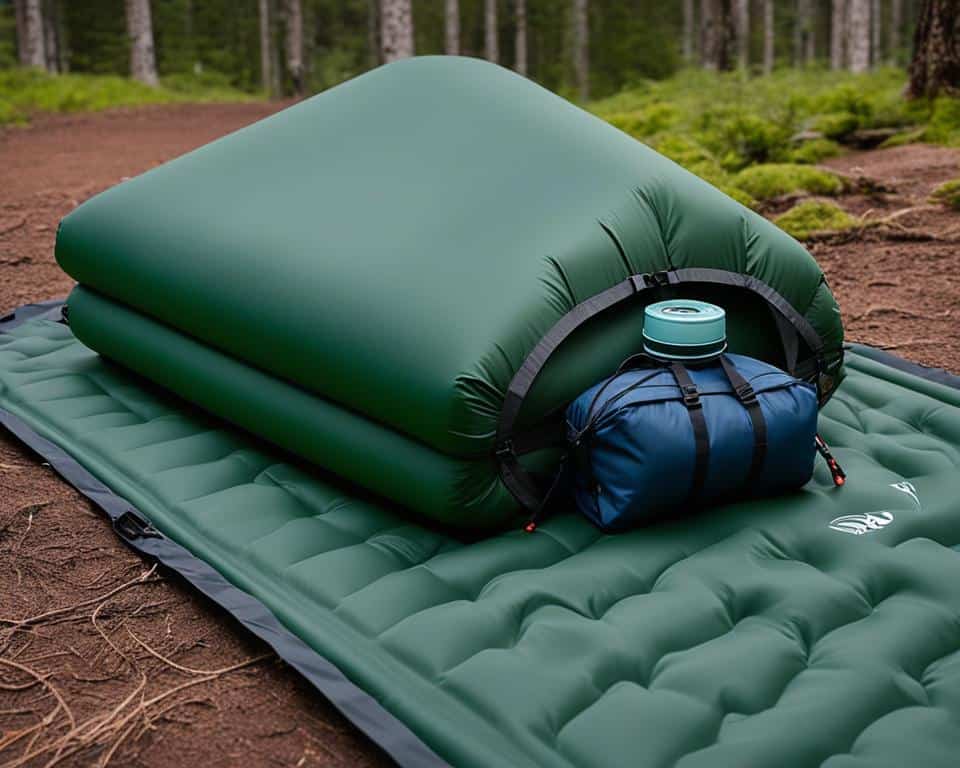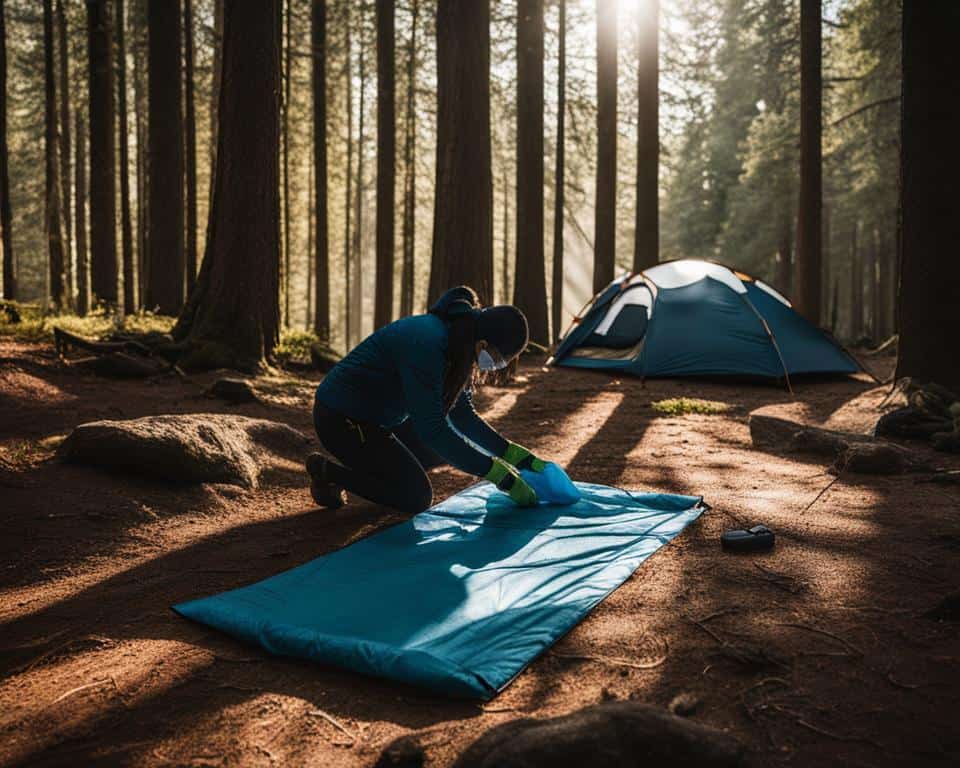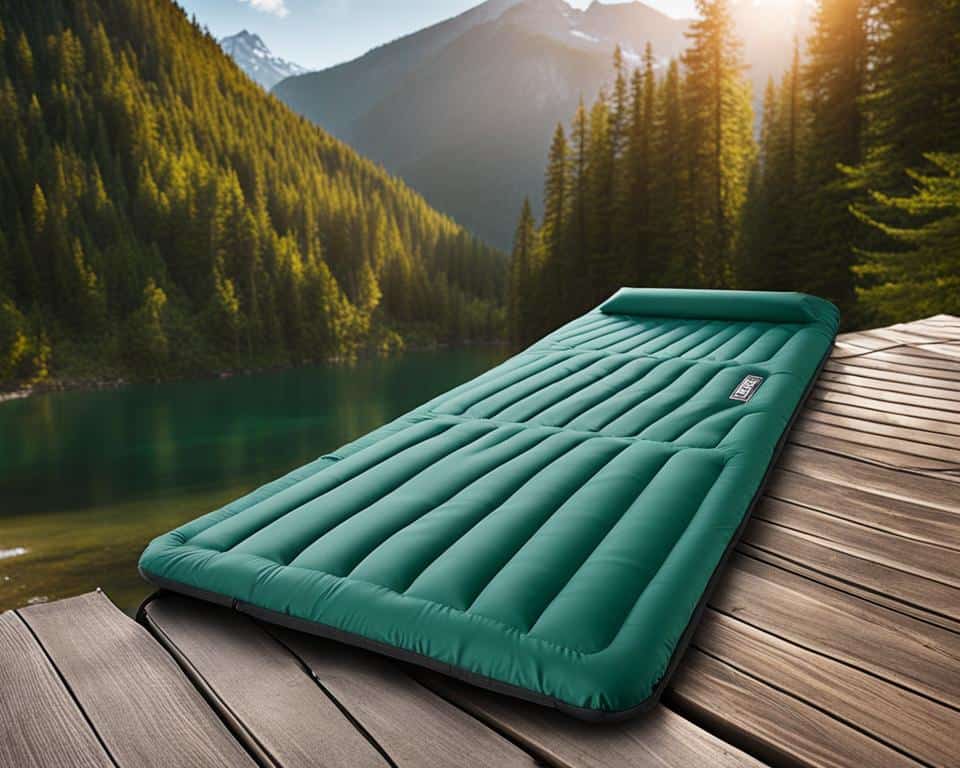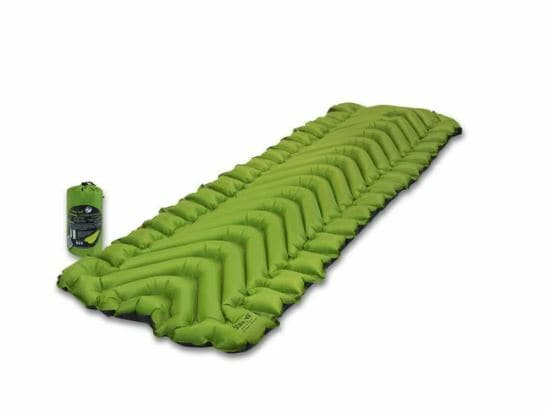
For many nature enthusiasts, camping is the ultimate escape to tranquility, but the rugged outdoors comes with its own set of challenges, particularly when it’s time to turn in. Prioritizing camping comfort is essential, and one of the most significant camping essentials is a reliable sleeping mat for camping. This humble piece of outdoor gear is more than a simple accessory; it’s the cornerstone of a restorative night’s sleep under the stars.
Whether you’re setting up a tent beside a serene lake or bivouacking on a mountainside, your choice of sleeping mat can make or break the adventure. With adept recommendations from the National Park Service, insights from Outdoor Gear Lab, and the wisdom of the American Camping Association, you’ll discover how the right sleeping mat contributes to camping bliss. It’s not only a matter of preference but of combining support, warmth, and protection from the unpredictable earth beneath. Let’s explore why an intentional selection in sleeping mats is key to mastering the art of comfortable slumber in the great outdoors.
Key Takeaways
- Comfortable sleep is crucial for full enjoyment and energy in outdoor adventures.
- The right sleeping mat provides insulation, cushioning, and protection from the terrain.
- Expert sources like the National Park Service guide campers on essential gear, including sleeping mats.
- Outdoor Gear Lab offers thorough reviews to identify top-rated sleeping mats for varied needs.
- American Camping Association endorses proper campsite setup, marking sleeping mats as indispensable.
- Learn about how sleeping mats elevate the overall quality of your camping experiences.
Why a Good Sleeping Mat is Essential for Campers
Embarking on an outdoor adventure often means trading the familiar comfort of your bed for the unpredictable nature of the ground beneath a tent. A quality sleeping mat, like the ones you can see at Dwights Outdoors, not only cushions against the hard and potentially uneven surfaces encountered while camping but also can prove critical in improving overall sleep quality and health out in the wild.
The Impact of a Sleeping Mat on Sleep Quality
Understanding the sleeping mat benefits starts with a closer look at the foundation of a good night’s sleep. Campers are often challenged by the ruggedness of the outdoor environment. Thus, a sleeping mat acts as a pivotal tool to improve sleep quality camping, by providing a smooth, cushioned surface that mimics the comfort of a traditional mattress. This can be especially beneficial after a day of strenuous activities, ensuring that your body recovers adequately through restorative sleep.
Insulation and Comfort: What a Sleeping Mat Provides
A sleeping mat serves as a critical barrier between you and the ground. The ground can sap body heat at an alarming rate due to its naturally cool temperature. A mat with sufficient insulation properties safeguards against this heat loss, offering the warm reprieve necessary for a comfortable sleep outdoor. This aspect of thermal insulation is often quantified in terms of R-value; the higher the R-value, the better the sleeping mat’s ability to keep you warm throughout the night.
Health Benefits of Using a Proper Camping Mat
The health implications of choosing an appropriate sleeping surface cannot be overstated. By preventing the body from lying directly on the cold, damp ground, a sleeping mat helps to thwart common ailments such as back pain and discomfort. Moreover, it supports proper sleep posture, which is fundamental in avoiding unnecessary strain on the body. This aid in spinal alignment and support is something even chiropractic professionals would laud for its role in maintaining the campers’ overall physical well-being.
Choosing the Right Type of Sleeping Mat
Embarking on an outdoor adventure means bidding farewell to the luxury of a conventional bed for a few nights. Yet, the choices in types of sleeping mats available today ensure that sleep quality doesn’t have to suffer. When you’re considering sleeping mat selection, key factors come into play including weight, size, insulation properties, and the environment you’ll be camping in. All these play a crucial role in how to choose a camping mat that meets your outdoor sleeping needs.
Weight is a pivotal consideration for hikers and backpackers for whom every ounce matters. A lighter mat might sacrifice a bit of comfort but will be a boon to those trekking long distances. The size of the sleeping mat can affect how it fits inside your tent and how easy it is to pack. Insulation is key for keeping the cold at bay, and it’s quantified by a material’s R-value—the higher the R-value, the warmer you’ll stay.
But what about the personal preferences that dictate your comfort outdoors? Your sleeping mat should reflect the level of comfort you desire and align with the space you have available for packing. REI Co-op’s expertise suggests considering how much space you have in your pack, as well as how you value comfort versus space. BACKPACKER Magazine’s insights also remind us that the right choice depends heavily on your camping style—be it ultralight backpacking or car camping.
“When it comes to finding the right sleeping mat, align your selection with your camping habits and comfort preferences. Test before you invest, and remember that the priciest options aren’t always the best for your individual needs.” – Shared wisdom from seasoned campers on outdoor forums.
Turning to feedback from diverse camping communities can provide real-life insights that go beyond the technical specifications. For instance, campers often share their sleeping mat experiences on forums, detailing their journey of selection for different climate conditions and terrains.
| Type of Sleeping Mat | Weight | Insulation (R-value) | Packability | Suitable Environment |
|---|---|---|---|---|
| Air Pads | Light | Variable | Highly Compressible | Mild to moderate weather |
| Foam Pads | Moderate | Low to Moderate | Bulky | Harsh terrain, quick setup |
| Self-Inflating Pads | Heavier | High | Moderately Compressible | Cold weather, rugged terrain |
Choosing the right type of sleeping mat can spell the difference between a restorative night’s rest and a rough morning. Consider this guide as a foundation to inform your selection and ensure that the next mat you lie on under the stars is the best platform for adventure-laden dreams.
Differences Between Air Pads, Foam Pads, and Self-Inflating Mats
When it comes to camping comfort and convenience, choosing the right kind of sleeping mat can make all the difference. Campers often find themselves weighing the merits of air pads vs. foam pads, not to mention the more recent emergence of self-inflating sleeping mats. A thorough camping pad comparison can help illuminate which type of mat will serve your outdoor needs best.

Air Pads vs. Foam Pads: Pros and Cons
Air pads and foam pads are the most traditional options for campers seeking comfort. Here’s a breakdown of their respective advantages and disadvantages:
- Air Pads: Known for their light weight and compact pack size, air pads provide excellent cushioning and are favored by backpackers. However, they can be prone to punctures and often require manual inflation.
- Foam Pads: With their durability and simplicity, foam pads are a reliable choice. They offer good insulation and are impervious to leaks. On the downside, they are bulkier and may provide less comfort than air pads.
Self-Inflating Mats: Are They Worth the Hype?
The self-inflating mat attempts to strike a balance by incorporating open-cell foam insulation and air. They offer the comfort of an air pad with the added benefit of self-inflation, making setup a breeze. Although they may be slightly heavier than a typical air pad, for many the trade-off for convenience and reliability is worth it.
Below is a comparison of the three types of camping pads based on several key factors:
| Type | Weight | Pack Size | Comfort | Durability | Insulation |
|---|---|---|---|---|---|
| Air Pads | Light | Small | High | Low-Medium | Variable |
| Foam Pads | Varies | Large | Medium | High | Good |
| Self-Inflating Mats | Medium | Medium | High | High | Excellent |
As we compare the characteristics of each sleeping solution, it’s critical for campers to consider their specific needs. Whether you prioritize the minimal weight of air pads, the foolproof nature of foam pads, or the all-around performance of self-inflating sleeping mats, understanding the fundamental differences will lead to restful nights under the stars.
The Best Sleeping Mat Features for Different Terrain
Whether you’re settling in for the night on an alpine ridge or camping in a snowy forest, the right sleeping mat can make all the difference. Understanding the features necessary for different terrains ensures not just a good night’s sleep, but also protection from the often harsh elements encountered in the great outdoors.
Mats for Rocky Ground: What to Look For
To survive the rugged challenges of rocky ground, a sleeping mat for rugged terrain should boast these essential features:
- Durability to prevent punctures from sharp stones.
- Increased thickness for adequate cushioning.
- Non-slip surfaces to maintain a stable sleeping position.
- Reinforced bottom layers for extended longevity.
Terrain-specific camping mats tailored for rocky environments often incorporate advanced materials that withstand abrasive surfaces while offering superior comfort.
Sleeping Mats for Cold-Weather Camping
Cold-weather adventurers need a mat that not only insulates but also stands up to the freezing temperatures of winter camping:
- Look for cold-weather camping pads with a high R-value, indicating better insulation.
- Opt for mats with a reflective layer to retain body heat.
- Choose mats made with materials that remain pliable in cold weather to avoid cracking.
- Inflate with a pump or include a breath-saving design to prevent moisture from breath affecting the insulation.
With these considerations in mind, a cozy and warm campsite is within easy reach, even when the mercury drops.
To further illustrate the critical features of terrain-adapted sleeping mats, here’s a comparison table that puts these elements side by side:
| Feature | Rocky Terrain Mat | Cold Weather Mat |
|---|---|---|
| Material Durability | High-density foam and reinforced fabrics | All-season, abrasion resistant fabrics |
| Thickness | 3-4 inches | 2-3 inches with additional insulation |
| R-Value | Varies based on manufacturer | 4 and above for superior warmth |
| Surface Texture | Textured to prevent slipping | Smooth for comfort, with non-slip bottom |
| Special Features | Puncture repair kit included | Reflective layers for heat retention |
By selecting the right sleeping mat designed for the specific demands of your chosen terrain, you elevate your outdoor experience by ensuring a restorative sleep, no matter where you lay your head.
How to Properly Maintain Your Sleeping Mat
To ensure the longevity of sleeping mats, regular maintenance is a crucial step that should not be overlooked. Effective sleeping mat maintenance not only enhances your comfort during camping trips but also protects your investment in quality caring for camping gear. The following are practical tips and best practices to help keep your sleeping mat in top condition.
- Cleaning: After each use, gently wipe down the mat with a damp cloth to remove any dirt, sand, or debris. For a deeper clean, use a mild soap solution, but avoid harsh chemicals that can degrade the material.
- Drying: Before storing, ensure your mat is thoroughly dry to prevent mold and mildew build-up. Air dry it outside, but away from direct sunlight which can damage the fabric.
- Storage: Keep the mat unrolled and inflated with the valve open if space allows, as this avoids creating permanent creases and protects the integrity of the material.
- Repairs: Carry a repair kit and familiarize yourself with patching small punctures or tears to prevent them from becoming larger issues.
- Manufacturer’s Guidelines: Follow any specific instructions from the brand for care and maintenance to maintain the warranty and ensure proper handling of the material.
Ignoring maintenance can lead to premature wear and tear, compromising the mat’s insulation properties and comfort. Below is a table comparing proper and improper maintenance practices and their impacts.
| Maintenance Practice | Proper Care | Neglected Care |
|---|---|---|
| Cleaning | Regular, gentle cleaning as per guidelines | Accumulation of dirt that degrades materials |
| Drying | Mat is fully air-dried to prevent moisture damage | Moisture remains, leading to mold and mildew |
| Storage | Stored inflated or flat to keep shape | Improperly folded causing creases and damage |
| Repairs | Immediate attention to punctures | Punctures worsen, requiring complex repairs |
| Manufacturer’s Guidelines | Preserves warranty and ensures best care | Potential voiding of warranty and mat damage |
“Regular care for your camping gear ensures that you can count on it to keep you comfortable and protected on many adventures to come.”
By incorporating these simple steps into your caring for camping gear routine, the longevity of your sleeping mat will be maximally extended, providing reliable performance trip after trip.

Top Rated Sleeping Mats in the Market
When comfort and the great outdoors intersect, savvy campers know that a superior sleeping mat is non-negotiable. This year, the quest for the best sleeping mats has revealed some standout candidates that promise to enhance the camping experience with their top-notch features and commendable user satisfaction levels. These mats are not just rated highly for their luxurious feel but also for their ability to adapt to varied camping styles and preferences. Below, we explore some of the finest options currently topping the charts.
Editor’s Choice: Best All-Around Mats
In the realm of top-rated camping pads, certain names echo louder than others. Garnering attention for their all-rounder capabilities—durability, comfort, and convenience—the Editor’s Choice mats are a testament to superior design and functionality. Whether you’re a solo backpacker or a family-on-wheels, these selections resonate with varied camping cadences, striking an ideal balance between luxurious comfort and practical utility.

Budget-Friendly Options Without Compromising Comfort
Money need not be a roadblock on your path to a restful night under the stars. The market blesses budget-conscious adventurers with affordable sleeping mats reviews that glow with positive feedback. These value-focused options defy their price tags by offering a slew of features that echo those of their pricier counterparts.
Whether your heart is set on the unrivaled comfort of the Alps Mountaineering Apex Series or the lightweight allure of the Klymit Static V2, rest assured that each pick embodies a commitment to quality and wallet-friendly prices. These mats prove that when it comes to finding the right balance, good sleep and affordability can indeed go hand-in-hand.
Packing Tips: How to Carry Your Sleeping Mat Efficiently
Embarking on a journey through the great outdoors means taking along all the necessities that can fit in your pack, and a sleeping mat is one item that should not be overlooked. The mat provides critical comfort and insulation, turning the rough ground into a sleep-friendly surface. Therefore, knowing how to pack your sleeping mat efficiently is paramount for any camper or hiker aiming to optimize their load with compact camping gear.
Sleeping mat packing doesn’t have to be a cumbersome ordeal. With the right folding techniques and attachment methods, you can secure your mat and save precious space. Some favored strategies include tightly rolling air pads, flat-packing foam mats against the backpack’s back panel, or using integrated straps to attach the mat to the outside of your pack.
Here are specific tips to help make your sleeping mat as travel-friendly as possible:
- Roll your air pad or self-inflating mat as tightly as possible, pushing out any air as you go to achieve a compact form.
- If you have a foam pad, consider cutting it to match the exact width and length of your backpack, which can then double as a frame.
- For quick access, attach the mat vertically or horizontally to the outside of your pack – just be sure it’s securely fastened and won’t get snagged.
- Leverage compression straps or a dedicated sleeping pad compartment if your backpack offers these features.
- Protect your mat from punctures by wrapping it in a sturdy bag or material.
- Consider a mat with integrated packing features, such as foldable segments or elastic bands.
Viewing how professionals manage their gear is always insightful. Table below mirrors the strategies from backpacking experts and thru-hikers, offering a comparison of packing methodologies for different types of sleeping mats:
| Type of Sleeping Mat | Packing Method | Bulk Size After Packing | Best Use |
|---|---|---|---|
| Air Pad | Tightly rolled, secured with straps/bands | Very Compact | Backpacking, where weight and volume are critical |
| Foam Pad | Flat-packed or lightly rolled | Bulkier than air pads | Short trips, durability a concern |
| Self-Inflating Mat | Tightly rolled, valve opened to expel air | Compact to Moderate | Versatile, balance between comfort and space |
Travel-friendly sleeping pads are designed with the journey in mind, blending functionality with ease of use. Whether you’re traversing mountain trails or setting up camp in a secluded forest, the convenience of a well-packed mat can enhance your adventure.

Nothing beats the peace of mind knowing that your sleeping mat is readily accessible and in perfect condition for a restful night’s sleep under the stars. By using these guidelines, you can ensure your camping gear is as travel-friendly and space-efficient as possible, without sacrificing the comfort that can make all the difference in your wilderness experience.
Enhancing Your Sleeping Experience with Additional Accessories
After selecting the ideal sleeping mat to ensure your resting base is secure and comfortable, it’s essential to consider the camping sleeping accessories that can elevate your slumber under the stars. A complete camping sleep system is not just about a singular item; it’s the synergy of multiple components working in harmony.
Pillows and Liners to Complement Your Sleeping Mat
Adding specialized camping pillows to your setup is a savvy move for optimizing camping comfort. These pillows are tailored to the needs of campers, offering support while being lightweight and easy to transport. Similarly, sleeping mat liners can help raise the insulation aspect of your slumber, especially when temperatures start to dip. Below is a comparison of popular pillow and liner options:
| Accessory | Type | Weight | Insulation Feature | Portability |
|---|---|---|---|---|
| Therm-a-Rest Compressible Pillow | Pillow | 9 oz | Memory Foam | Highly compressible |
| Sea to Summit Aeros Pillow | Pillow | 2.8 oz | Layered synthetic fill | Ultra-light & compact |
| ALPS Mountaineering MicroFiber Liner | Liner | 1 lb 5 oz | Microfiber | Easily packable |
| Sea to Summit Thermolite Reactor Liner | Liner | 8.7 oz | Thermolite fabric | Compact design |
The Role of Tents and Sleep Bags in Overall Comfort
The choice of tents and sleeping bags is paramount, not only for providing a sheltered space but also for ensuring your overall warmth and comfort. A high-quality tent shields you from the elements, while a snug sleeping bag preserves your body heat. Yet, it’s the combination of these with a reliable sleeping mat that truly optimizes your rest.

‘It’s not just about stacking gear; it’s about assembling a sleep system that works collectively to provide the best outdoor rest possible.’ – Outdoor Equipment Experts This quote underpins the essence of creating a tailored sleep environment while camping – one that is designed with your specific comfort needs in mind.
By carefully considering the added value that pillows, liners, tents, and sleeping bags bring to the table, you can rest assured that you’ve set the stage for a night of rejuvenating sleep, no matter where your adventures take you.
Conclusion
As we have explored the multifaceted world of outdoor sleeping solutions, the consensus among outdoorsmen and experts alike solidifies the standing of a quality sleeping mat as an unrivaled piece of essential camping gear. This essential item forms the foundation of comfort and plays a pivotal role in ensuring that a day filled with adventure is complemented by a night of restorative slumber.
Summarizing the Importance of a Quality Sleeping Mat
Amplifying the appeal of the great outdoors, investing in a superior sleeping mat serves as a smart camping investment, offering the robust combination of durability and value. Expert opinions converge on the principle that the right mat will not only cushion your body against the uneven ground but also insulate you against the chilly embrace of the night, securing a protective niche within your camping setup.
Final Thoughts on Making Comfort a Priority
In essence, prioritizing sleep outdoors by selecting an exemplary sleeping mat translates directly to an enriched camping experience. Testimonials from seasoned nature lovers laud the virtues of being well-rested beneath the stars, while psychological studies underscore the overarching impacts on mental health and happiness. The pursuit of outdoor ventures is elevated when afforded the guarantee of a comfortable retreat at day’s end, making the humble sleeping mat not merely a gear element, but a fundamental tenet of a truly joyful adventure.
FAQ
What qualities should I look for in a sleeping mat to ensure a comfortable camping experience?
When searching for a sleeping mat, you’ll want to focus on its support, warmth retention, and ability to provide a barrier from rough or uneven terrain. According to the American Camping Association, a good sleeping mat is essential for achieving the kind of restful night’s sleep that rejuvenates you for the next day’s activities.
How does a sleeping mat improve my sleep quality while camping?
A sleeping mat helps to create a smooth, cushioned surface that can significantly improve sleep quality. It provides insulation from the cold ground, maintaining body heat and comfort through the night. The Sleep Foundation has reported that sleeping on the right surface can positively impact your sleep quality, including when you’re out in the wild.
Are there any health benefits to using a sleeping mat while camping?
Absolutely, sleeping mats can help prevent back pain by offering proper support, improving your sleep posture, and keeping you off the damp ground, which can be detrimental to your health. Chiropractic associations often discuss the importance of sleeping support, particularly when you’re away from your regular bed.
With so many types of sleeping mats available, how do I choose the right one for my camping trips?
The right sleeping mat depends on a variety of factors including weight, size, insulation properties, and the specific camping environment. Consider what’s most important to you, whether that be the level of comfort, the amount of packing space, or the type of camping you plan to do. Expert advice from REI Co-op can be a valuable resource in your selection process.
How do air pads, foam pads, and self-inflating mats differ?
Each type of pad has its pros and cons. Air pads tend to be lighter and more compact but can be punctured more easily. Foam pads are durable and provide excellent insulation but may be bulkier. Self-inflating mats offer a balance between the two, with convenient setup and pack-down. You can check out comparison reviews from outdoor gear publications for detailed analysis.
What features should I look for in a sleeping mat for rough terrain?
For rocky or uneven ground, you’ll want a mat with enough thickness to cushion against the terrain, and durability to withstand potential punctures. When camping in cold weather, insulation is key. Look for mats with high R-value ratings that signify better insulation, ensuring warmth and comfort throughout the night. Gear testing outcomes can provide insight into which mats perform best in such conditions.
Can you offer some tips on maintaining my sleeping mat?
To maintain your sleeping mat, you should clean it after each use, store it properly (usually unrolled and with the valve open to avoid moisture buildup), and repair any punctures or damages promptly. Following the manufacturer’s care guidelines is essential. For example, Nemo Equipment provides details on care and maintenance that could help extend the lifespan of your mat.
What are some of the top-rated sleeping mats on the market?
The market offers a broad range of top-rated sleeping mats catering to different needs and budgets. Editor’s choices in gear awards can guide you to all-around excellent mats while customer ratings can help you find budget-friendly options that do not compromise on comfort. Websites like OutdoorGearLab provide comprehensive reviews and ratings on various sleeping mats.
How should I pack my sleeping mat to save space during my trip?
Efficient packing methods vary depending on the type of sleeping mat you have. Generally, it’s best to roll up your mat tightly, remove as much air as possible, and use straps or a carry bag to secure it. Some mats can be attached to the outside of your backpack, saving valuable space inside. Insights from backpacking experts like those from TheTrek can be highly beneficial here.
Besides a sleeping mat, what accessories can enhance my sleeping experience while camping?
To optimize your sleeping experience, consider adding specialized camping pillows and liners for additional warmth and comfort. The right tent and sleeping bag can also significantly contribute to overall comfort, creating an ideal sleep system that complements your mat. Outdoor equipment brands often advertise product synergy that can inspire your choices for a cohesive setup.











































